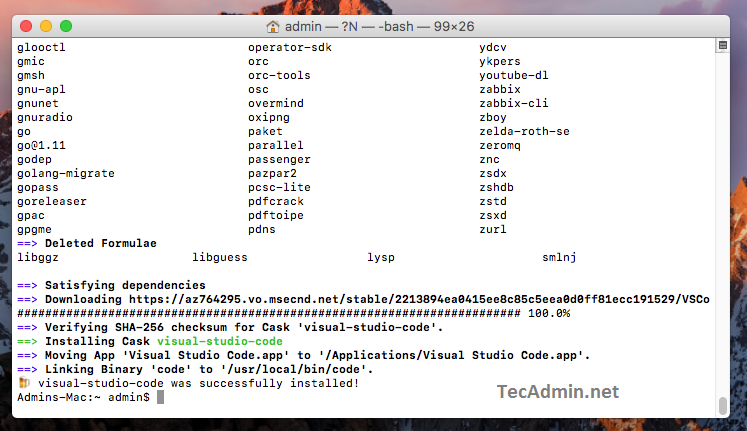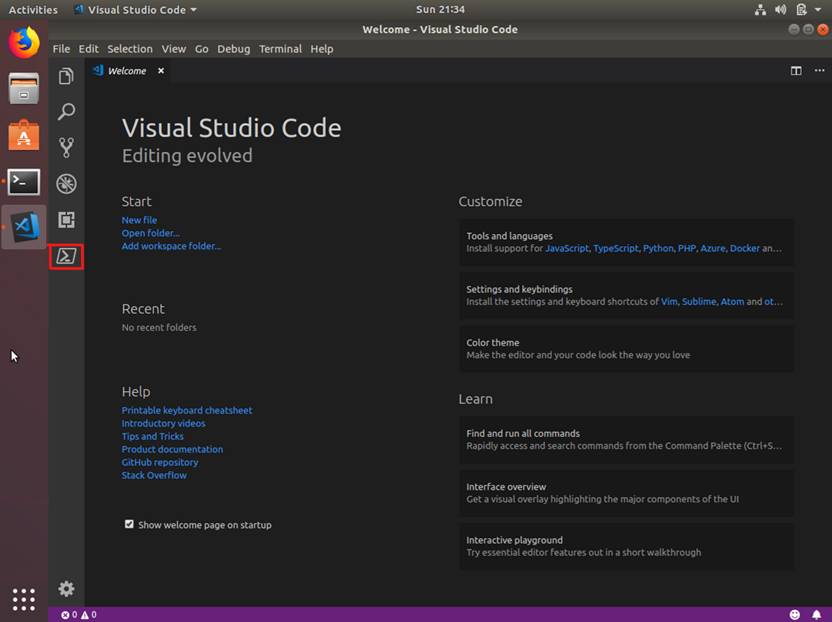- Brew Cask Install Visual Studio Code For Mac
- Brew Cask Install Visual Studio Code Download For Windows 10
- Brew Cask Update
- Brew Install Cask
- Brew Cask Install Visual Studio Code In Linux
Dismiss Join GitHub today. GitHub is home to over 50 million developers working together to host and review code, manage projects, and build software together. After upgrading my OS to Sierra I was having an issue with homebrew. It failed to recognize the cask command and was throwing an error: brew cask install haskell-platform Error: Unknown command: cask Brew wasn't able to find the correct path and was causing this issue. Nov 04, 2017 Installing multiple versions of Python on Mac December 2, 2020 In 'Programming' Mac install MySQL using brew December 8, 2016 In 'Database' Mac Upgrade Nodejs and NPM on Brew September 14, 2017 In 'System'.
These scripts leverage Homebrew, the package manager for Mac. Click here to learn more about Homebrew.
QuickStart Overview
Starting out in DataOps requires a new set of tools from what developers may have used previously. Thankfully, package managers like Chocolatey and Homebrew exist to streamline the process of getting new software installed (and keeping it updated) on your machine.
The package manager reduces the time to get software installed, saving hours of time and ensuring everyone’s machines are setup correctly with minimal effort. Here’s a quick overview of the tools you’ll install in the next section:
- A package manager: Chocolatey (for Windows) or Homebrew (for Mac)
- Docker - to run containerized apps and create your own.
- Git - a version control platform used to store and manage code.
- GitHub Desktop - a friendly GUI which works with Git and GitHub.com.
- Python - a software language useful for developing new programs and scripts, and also used for its popular package manager
pip, which allows users to install Python programs written by others. - Terraform - the leading cross-platform solution for automating Infrastructure as Code (IaC).
- VS Code - a robust, fast, and lightweight development environment (IDE).
Installing Homebrew and Core Tools
- Open “Terminal”.
Paste and run the Homebrew install script:
Install git.
Install core tools:
Installing additional tools
After following the instructions from the above, you should now have the Cakebrew app installed, which gives a friendly GUI on top of the Homebrew installer.
To install any additional programs, either open the Cakebrew app or copy-paste the below samples into a Terminal window. (You can also find additional packages at https://brew.sh.)
brew install awsclibrew install azure-clibrew install elasticsearchbrew install gradlebrew cask install anacondabrew cask install dbeaver-communitybrew cask install githubbrew cask install google-chromebrew cask install microsoft-teamsbrew cask install pgadmin4brew cask install rbrew cask install slackbrew install aws-sam-cli**You might first need to run:brew tap aws/tapbrew cask install selenium-server-standalonebrew cask install firefox
Extra Credit: Create a GitHub Account
For extra credit, visit GitHub.com and register a new account. Once you’ve created a GitHub account and installed the core software, you are all all set to contribute to open source projects in GitHub, including this one!

- Tip: Rather than create multiple accounts, we recommend using a single GitHub account for both work and personal development projects.
Related Links
- Brew QuickSetup Script: https://docs.dataops.tk/setup/brew_install.sh (source)
Intro
A few weeks ago I discovered Visual Studio Code and started using it for some of my work. (Note: I’m using multiple editors/IDEs all the time, based on the task; Emacs, Sublime, Atom, IntelliJ, VS, etc.) So far Code is my favourite among the set of similar editors, such as Atom. I was pleasently surprised how well it works with its integrated OmniSharp plugin on bari’s codebase, so I decided to try to write a bari plugin for it.
Writing an extension for Code was a nice experience. The outcome is the bari build management extension, which I’ll demonstrate in the next section.
Developing .NET applications with Visual Studio Code and bari
As Code is multiplatform, and bari also works with Mono, I’ll demonstrate how you can use these tools to develop a .NET application (actually bari itself) on a Mac. The steps here (except installing Mono) would be the same on Windows or Linux as well.
Installing the tools
First, if you are not on Windows, you’ll have to install the latest Mono framework. On OSX I recommed to use brew to do that:
Then get the latest Visual Studio Code version, either by downloading it from its homepage or with brew cask:
Get the latest bari. On Windows I recommend downloading and extracting the latest official release and adding it to the PATH. On OSX, with mono we already have nuget, so let’s use that:
and create a script to execute it somewhere in your PATH:
That’s it. Future versions of the bari extension will probably be able to install bari itself.
Let’s start Code now!
Installing the extension
Open the command palette (F1, or ⇧⌘P) and type ext install bari
Loading the project
After that restart the editor. Have your bari-built project available somewhere. As we are going to develop bari itself, let’s clone its repository:
Then open the result bari directory with Code. This should look like the following:
The bari plugin automatically detected that the opened folder has a suite.yaml in its root, and loaded it. That’s why we can see the two sections on the statusbar’s right side: full and debug. The first one is the selected target product and the second one is the selected goal. All the bari commands provided by the extension will be executed with these settings.
Changing the target
To change the active product or goal, you can click on the statusbar or use the command palette (F1, or ⇧⌘P) and choose bari: Change goal or bari: Change target product.
Let’s change the goal to debug-mono, as we are working on a non-Windows environment:
Generating the solution
The next step before starting coding is to actually generate the solution and projects files (and fetch the dependencies, etc.) so OmniSharp can load it and provide code completion, analysis, etc. features.
To do so, just use the command palette and choose bari: Regenerate solution, which runs the bari vs command with the correct parameters. The command’s output is displayed in an output panel called bari. This looks like the following:
Brew Cask Install Visual Studio Code For Mac
There’s nothing else left than pointing OmniSharp to the generated solution, with the following command:
Brew Cask Install Visual Studio Code Download For Windows 10

It will automatically find the generated .sln file, just select the correct one:
In a few seconds (and with a few warnings for this project), OmniSharp works. To see what it can do, check this page. A simple example is to jump to a given class or interface with ⌘P:
Working on the project
You can work on the project and build it from Code or run its tests using the bari: Build and bari: Test commands. The build output will be shown just like in the solution generation step.
Whenever the suite definition itself must be modified, you can jump there with the bari: Open suite.yaml command and then just regenerate the solution as it was shown above.


Implementation
Brew Cask Update
The implementation was really straightforward. The source code can be found here. It’s basically a JSON defining how the plugin is integrated and some implementation code in TypeScript. It’s easy to run and debug the plugin from Code itself.
Brew Install Cask
For example the following section from the extension definition describes what events triggers the extension:
It’s either done by invoking one of the defined commands from the command palette, or if the opened workspace contains a suite.yaml. The latter enables the extension to parse the suite definition and initialize the statusbar immediately one the suite has been opened.
The package definition also specifies the provided configuration values, such as:
The implementation itself is really simple, all the user interface elements involved such as the console output window, the command palette, the statusbar panels can be easily managed.
For example the panel showing bari’s output is created by the following code snippet:

Or to display the result of an operation:
or to create the statusbar panel:
This API is simple and well documented enough so basic integrations like this can be done in an hour.
Brew Cask Install Visual Studio Code In Linux
Please enable JavaScript to view the comments powered by Disqus.comments powered by Disqus